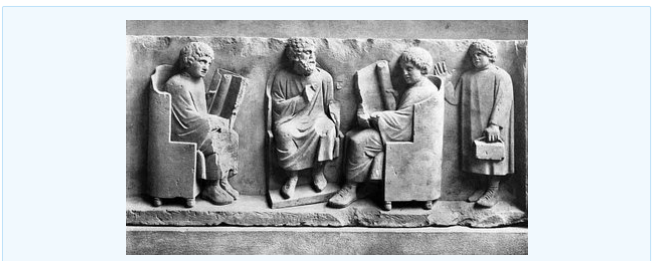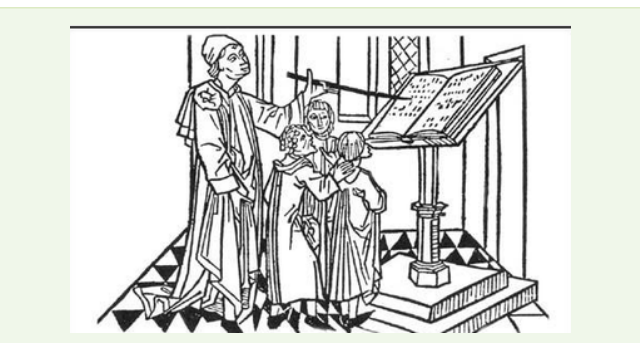Period 1: The Beginnings of Education Ancient Greece
Ancient Rome
The education of the latter was influenced by the Greeks (Parkay, 2019). Previously, Roman children were taught at home, however, after the adoption of the Freek system they attended schools where students were taught in groups. The parents had to pay for this type of education, hence, it was not accessible for all (“Education,” n.d.). Both boys and girls were able to get an education. The system consisted of three levels – “Ludi,” “Ludus,” and secondary school (Parkay, 2019). Boys were able to attend grammar school after they reached the age of 12, although this was an option mainly for privileged individuals. After 16 and until they reached their twenties, they went to rhetoric schools with more advanced subjects such as music, arithmetic, astronomy, and other subjects.

Middle Ages
The education of the era was influenced by the Roman Catholic Church. Similar to the system used in Ancient Rome, there were three types of schools in the middle ages – “elementary song-school, the monastic school, and the grammar school” (“Education in the Middle Ages,” n.d., para. 1). The schools were attended by boys primarily from young ages until their young adulthood while girls were homeschooled (“Medieval schools,” n.d.). The parents of the children paid for the education, although in some cases boys were allowed to attend classes in exchange for work. The school setting was connected to a religious institution, for example, elementary schools were usually a part of a church. The materials and subjects were based mainly on Biblical teachings.

The Renaissance
Next, during the Renaissance, the approach to school education changed, with less focus on the religious aspect and more attention towards the sciences with subjects such as “history, astronomy, music, and geometry” being the priority (“What were the changes in education during the Renaissance?” n.d.). Both schools and higher education institutions functioned, providing education to all people from young ages to adulthood (Parkay, 2019).
The aim of education changes as well, since the objective was to prepare well-rounded people. Vernacular schools were established for the primary education of boys and girls (“Education history,” n.d.). Additionally, upper-class individuals could attend preparatory and secondary schools. Also, forms of schools such as gymnasiums and lycee emerged in different parts of Europe, teaching grammar, Latin, and Greek.

Period 2: Transitions in Education
America’s Independence to the Civil War (1776-1850’s)
During America’s Independence Civil War, the education system adjusted to the needs of the developing state, with more focus on practical subjects, and the state began supporting common schools from the 1820s (“Education,” n.d.). The materials used in schools were locally printed books and newspapers, In general, during this period, the United States was turning away from Europe and the new leaders aimed to develop a distinct system of education.
One example is Benjamin Franklin and his private secondary school the Philadelphia Academy (Parkay, 2019). Such academies emphasized the teaching of English instead of Latin. (Parkay, 2019). In most cases, they were privately funded, with some support provided by the local public funds. In most cases, young boys received education in these institutions, although some academies providing education to girls emerged as well, for example, Pierce’s academy.

Civil War to 1900
During the Civil War, the education system was not unified, with teachers relying mainly on their materials and expertise (“Education during the 1860s,” n.d.). The children in the Noth and South did not attend classes for several months to be able to harvest. The school setting differed, although in many cases students of different ages and grades were taught in the same room (“Education during the 1860s,” n.d.).
Professional teacher organizations began playing an important role in the development of the system (Parkay, 2019). However, the role of the government in these systems began increasing, aiming to provide education to a wider population, since prior the students had to pay tuition fees (“The 1850s and beyond,” n.d.).

Changes in Schools: John Dewey, Testing Movement, Cardinal Principles
John Dewey brought some revolutionary ideas to the field of education, mainly because of his idea of progressive education. This approach implies that a person learns best when they do something (“John Dewey on education,” n.d.). His laboratory school allowed children to work in collaboration with others and master cooking, sewing, or other practical matters, which is the main pro. The downsides of this approach are the focus on practical things only, with little attention to subjects such as literature.
Testing Movement Emphasised the need to establish a standardized approach that would be used across schools to test student achievements. The pros of the approach are the ability to establish metrics based on which all students are evaluated, while the cons are the difficulties associated with testing children taught through different methods. The Commission on the Reorganization of Secondary Education issued the Cardinal Principles which outlined the main goals of secondary education, which also allowed for a more standardized approach (Parkay, 2019).
The outcomes of these changes had a positive impact on today’s education, with a focus on students and standardized approaches to testing achievements.

Period 3: Post World War II to Present
International Challenges (space race, Sputnik, Cold War, etc.)
After World War II, the education system in the United States experienced difficulties. After 1957 the Sputnik developed in the Soviet Union emphasized the need to focus more on science education (Parkay, 2019). Moreover, the tensions between the Union and the States implied that some changes were necessary to improve the education system. The main issues included a lack of funding and problems faced by the education system after the War. However, the cons include the accountability movements and the activism of parents that helped improve the system, with more emphasis on learning sciences (Roos, 2019).

The Creation of Middle Schools
In the 1950s Howard became the first advocate for reorganizing the school system (“Middle Schools,” n.d.). In 1965 the Elementary and Secondary Education Act (ESEA) was enacted by Congress (Parkay, 2019). This approach was tailored towards a gradual transition between early education and high school, although it added complexity to the system. This was a part of President Johnson’s program “Great Society.” The act allowed for better access to education for children from poor families in the United States.

High-Stakes Testing
The ESEA led to the development of standardized testings. This was a part of the government’s response to Sputnik because students would not get a diploma if they failed (Parkay, 2019). The main benefit of this test is the increased accountability of the teachers and students (Jones and Ennes, 2018). The main issue with these tests is that they do not account for a variety of abilities and knowledge that a student can have. However, they shaped the modern education system.

